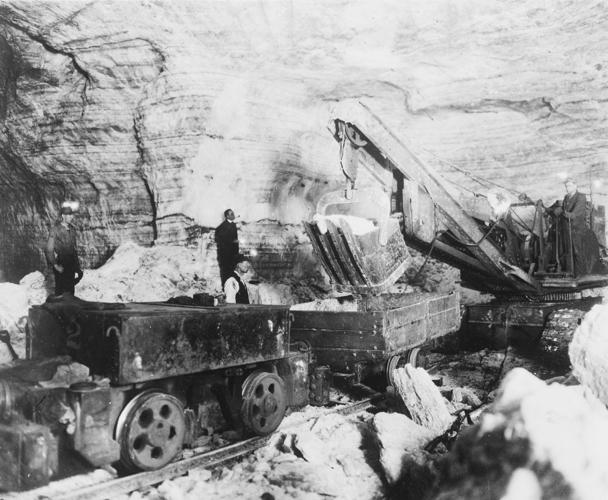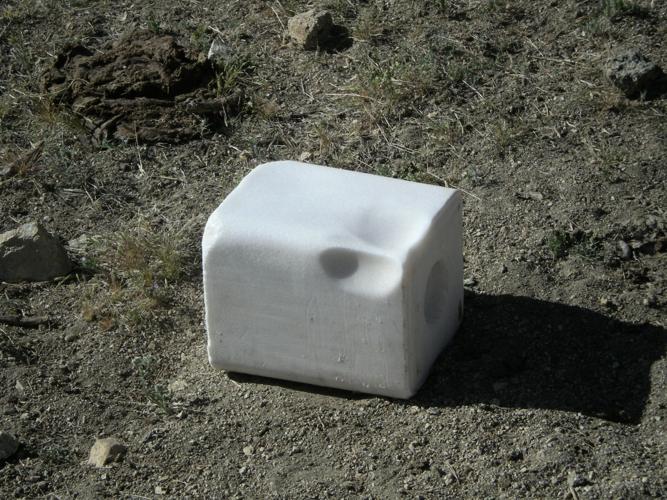U.S. soldiers stationed at Camp Verde in the 1870s acquired salt as a dietary supplement for their animals from a nearby hill.
Open pit mining commenced at the site in the 1920s under the Western Chemical Co. Using steam shovels and blasting on the eastern flank of the same hill, revealed earlier workings of the Native Americans.
No timbering or pillar support was discovered in the underground tunnels dating hundreds of years. Remnants of cedar bark torches indicate how lighting was generated inside the tunnel.
Additional evidence early miners left behind included stone picks and sandals composed of yucca leaves. The Native Americans followed the salt stratum as they commenced to tunneling, sometimes in excess of 70 feet vertically and horizontally.
The salt at the Camp Verde Mine occurs as transparent crystalline cubes of halite, some weighing in excess of 20 pounds.
Production reached its height in the 1930s. However, the world market demands salt purity of 99 percent, while the Camp Verde deposit was limited to 92 percent purity.
Higher purity means less manufacturing and processing cost coupled with the savings of disposing of waste brines.
Subsequent attempts to reopen the Camp Verde Mine never materialized.
Another early salt mining venture in Arizona involved the Hopi Salt Trail, a trail used by the Hopi over the centuries to gather salt from the Grand Canyon.
The salt coated the cliffs going up more than 50 feet, and was also found in caves farther downstream, averaging 84 percent purity. The Hopi used the salt for culinary and ceremonial purposes.
Today’s Arizona salt industry employs both solution mining and subsurface storage.
Morton Salt at the Luke Salt Body in Glendale extracts salt by solution mining, a process involving injecting water into a salt body 1,000 feet below the surface. The mixture of salt water then gets pumped back up to the surface.
A dozen retention ponds located on 100 acres of land are used to store the salt water, which evaporates in the desert sun, leaving behind a solid mass of salt contributing to Morton’s annual Glendale site production of 7.3 million bags of salt.
Because of its low magnesium and calcium content, the salt is used to produce chlorine for swimming pools andf as an additive for oil-well recovery and water softeners.
Palo Verde Nuclear Generating Plant uses water mixed with the salt harvested by Morton Salt as an enhanced coolant.
Salt deposits can be used for subsurface storage of natural gas, as in the case of Adamana and Bumstead, in Arizona. Their proximity to railroads and interstate pipelines helps enablestransportation of related storage items.
Salt solution caverns beneath Glendale and Holbrook provide storage of liquefied petroleum gas.
Salt solution caverns are preferred storage rather than surface storage in steel tanks because of the impermeability of the confines, preventing gas from escaping.
A 50-million-gallon storage cavern accommodates liquefied petroleum gas from 1,500 rail cars.
Salt also plays a role in weather modification.
Cloud seeding involves spraying salt crystals, dry ice and silver iodide into the supersaturated air, enhancing precipitation in drought-stricken areas around the world.
Global fresh-water shortages due to population growth and climate have necessitated salt removal from ocean water.
Oceans contain 96.5 percent water and 2.5 percent salts, requiring the use of desalinization plants to remove salt from the water to create potable water to compensate for natural shortages.
In 1963, Buckeye was the first town in the United States to build a desalination plant, which converted brackish underground water to drinkable water for municipal use.
That trend continues to this day in the arid Southwest.





